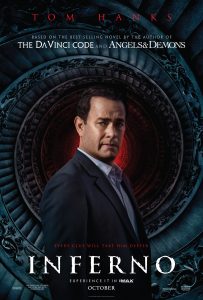
There’s a twist halfway through “Inferno” that’s so stupefying it derails the entire production! It’s the kind of twist reliant solely on shocking the audience, paying no mind to how it plays into the film’s continuity. It results in backtracking of the highest order to explain the convolution, an explanation in which relies on mere plot convenience. Characters must act precisely in accordance to the twist or else it doesn’t work. There’s no logical way those orchestrating the twist would know how the puppets involved would maneuver; they’re acting on blind luck and playing it off as brilliance.
That’s not to say Ron Howard’s adaptation of Dan Brown’s novel was good up until the twist. It was a lackluster mystery thriller utilizing cheap parlor tricks to uphold its story. At the very least, it was competently constructed, with those cheap parlor tricks working mildly. I liked how Howard utilized piercing sounds and blurry distortion to complement the protagonist’s head trauma. Said head trauma causes visions of Hell, replete with body mutilations, plague masks, seas of blood, and the titular inferno. These visions are presented in static quick cuts, sometimes cleverly matching the surrounding imagery of reality. The velocity of it all can be quite haunting, albeit in a forced manner.

ROBERT LANGDON (Tom Hanks) and SIENNA (Felicity Jones) in Columbia Pictures’ INFERNO.
These visions of Hell are had by Professor Robert Langdon (Tom Hanks), the hyper-intelligent scholar who saved the day in both “The Da Vinci Code” and “Angels and Demons.” Recent head trauma has caused short term memory loss at the worst of times, as he’s now awaken to discover he’s involved in a conspiracy theory that, if true, will enact a plague in which will wipe out half of the Earth’s population. Said plague is tied into Dante’s Inferno, which the Professor is able to deduce in record time despite his mental ailment. No head trauma can deter the superhuman abilities of a protagonist in a hokey thriller.
Aiding the Professor is Sienna Brooks (Felicity Jones), the doctor caring for him in Italy. The two bolt for safety when mysterious agents descend upon the hospital in search for the Professor. Sienna is willing to assist Langdon as she grew up a huge fan of his, reading his work from the age of nine. How mighty convenient that is! What ensues is a low-rent mystery that follows the mechanics of a spy thriller, our protagonists narrowly avoiding capture via stunts and cunning. They piece together the pieces of the puzzle with relative ease, much the same way the protagonists in “Jack Reacher: Never Go Back” did. Just like that film, the lack of danger resulted in boredom. No suspense equals no interest.

Tom Hanks and Sidse Babett Knudsen star in Columbia Pictures’ “Inferno,” also starring Felicity Jones.
This is the problem I’ve had with all of Dan Brown’s mysteries. They present themselves as high-minded, the characters all intelligent. The twists and turns themselves, however, are anything but. They are standard order thriller techniques, the kind you’d find in mindless cheese. Those thrillers at least embrace their campiness, in search for entertainment from the roller coaster thrill of it all. They relish on the audience shutting off their brain and enjoying the ride. Here, shutting off one’s brain goes against the grain. I am to turn my brain on to unravel the clues and notice the nods to classic art and literature. Yet, I feel as if I’m asked to shut my brain off in order to accept the ham-fisted contrivances. The awkward juxtaposition causes the mystery to lose its footing.
At least “The Da Vinci Code” and “Angels and Demons” didn’t rely on such a ludicrous twist. I am avoiding spoiling it, but trust me when I say it was detrimental to the intelligence of all involved. Credit where credit is due, Ron Howard and screenwriter David Koepp tried their damnedest to make it work, covering their tracks and offering up explanations. Still, too much plot convenience and suspension of disbelief is in order to accept it.

ROBERT LANGDON (Tom Hanks) and SIENNA (Felicity Jones) run for their lives through Boboli Gardens in Columbia Pictures’ INFERNO.
I could suspend my disbelief that a billionaire, Bertrand Zobrist (Ben Foster), would buy into the conspiracy of a plague and even help fund it. I could accept the superhuman abilities of the protagonists in solving complex anagrams and brain twisters in order to move along the plot. Hell, I was willing to accept that the conspiracy theorists would tamper with sculptures and Dante’s Inferno to concoct a riddle to appease their beliefs and ultimately serve the mystery. I didn’t like the execution of any of these conventions, but I was willing to accept them at the behest of the story. I wasn’t willing to accept the insipid twist, which only served to remind me how insipid the entire affair was.
No amount of parlor tricks, slick production, creative direction, endearing performances, or a fine Hans Simmer soundtrack could salvage the mess that was “Inferno!” I wish I had watched Dario Argento’s “Inferno” instead.
Final Rating: D+
